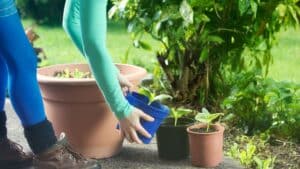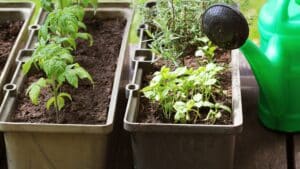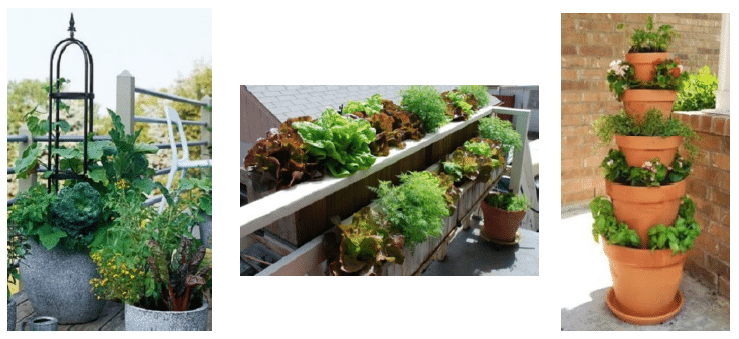
Patio Gardening Tips
“Container to Table!”
Patio Gardens in small spaces like balconies, patios and courtyards can produce enough to substantially offset your grocery purchases. Consider these patio gardening tips that start with doing it in a way that fits with the aesthetics of your outdoor living space. You can apply the same design elements for arrangements of herbs and vegetables as you would any container, to include considerations about color, texture, form, scale, repetition etc. Many vegetables and herbs have attractive features and can be successfully mixed with non-edibles to make a pleasing display.

Container and Support Types: Almost any kind of container will do for herbs and vegetables as long as it has drainage holes. Black pots and metals will absorb more heat. Condensed rubber “pot risers” or ceramic feet can be used to keep the pots off the ground or flooring, so they drain better and don’t cause staining. Containers have the advantage of mobility so you can position them for optimum sun or shade as the season changes.
Strawberry jars can hold an assortment of small herbs. Fabric grow bags have their place too and are especially good for growing potatoes. They can be easily folded and stored when not in use.

Use structures such as a low wall with an interior trough to create planting opportunities for small low herbs like colorful thyme or oregano. Trellises can fit between other structures of a patio or courtyard to provide support for climbers. Or they can lean against a wall or fence. A climbing bean can be planted with a more ornamental climber such as a black-eyed susan vine or cold-sensitive mandevilla, and both be removed at the end of the season. Tee pee type trellises made of bamboo stakes can also be positioned around a pot. Place supports at planting time, to lessen damaging roots and stems.
Pallets can be lined with weed cloth, filled with light weight soil and planted with small annuals, lettuces or herbs. Once seeds have germinated and matured 2-3 weeks, or transplants have grown in a week, the pallet can be leaned and made more vertical to take up less space.
Vertical living walls can be created from many materials and Rockaway’s design department has been involved with some. Just keep in mind that depending on the construction of your wall, it may need to be protected from the constant moisture.
Window boxes are an option too, for small to medium plants like parsley, dill, chives, cilantro or thyme, whether they’re on your house, balcony or deck railing. Cherry tomatoes and strawberries can be grown in hanging baskets. An iron basket of nasturtiums on a gate is quaint. Even gutters can be configured to a certain length, painted and drainage holes added for an unusual but useful herb garden.

How to Grow: The soil mix and moisture level are probably the two most important considerations for container growing. The soil should be well draining. If you created the “square foot gardening mix’ for a raised planter earlier this spring, this same formula can be used – 1/3 peat moss to 1/3 vermiculite and 1/3 compost. Alternatively, others have used 2 parts potting soil to 1-part compost and 1-part peat or vermiculite. Refer to our Planting Guide for North Florida Vegetables and our Planting Guide for North Florida Culinary Herbs for recommendations of sun exposure and other needs for individual crops. Fertilize with a slow release organic fertilizer at planting and then beginning about a month later apply soluble liquid fertilizer every 1-2 weeks using a 15-30-15 formula for fruiting vegetables and root crops, and a 20-20-20 formula for leafy vegetables. Container herbs should instead be followed with half recommended dose to avoid lush growth that has reduced flavor and aroma.
See below for recommendations of container size. The minimum soil depth for most herbs and greens is about 6 inches, but a larger pot is easier to keep well-watered. Most vegetables need about a 5-gallon container. Save the largest containers for climbers that need a sturdy trellis, such as vining beans, vine tomatoes, Malabar spinach, cucumbers, peppers, squash and melon. Use self-watering pots and automatic drip waterers where possible to reduce your maintenance.
Additional Tips:
- To maximize space, you can plant root crops, low growers and climbers in the same pot. Some low growers like lettuces would prefer the part shade provided by the taller plants.
- Start beans, corn, carrots, and radishes from seeds sown directly into the pot. If you use transplants of bunching onions, okra, melons and squash, take extra care in handling them.
- Group plants with similar sun and moisture needs.
- Because of its aggressive growth, mint is usually best grown in a pot by itself.

Plant Suggestions: Almost any herb can be grown in a container. The following vegetables are easy, productive choices for container gardening:
Asian Greens – such as Bok Choy. Use a container that is at least 20 inches deep by 12 inches wide per plant.
Beans – need a pot that is minimum 12 inches deep / 5-gallon capacity, and a strong trellis structure for support. A larger pot would allow additional plants like kale and celery to grow alongside. There are bush varieties that don’t require support.
Beets – direct seed into a 2 to 5-gallon container.
Carrots – Container size (6 – 15 inches deep) may vary according to the carrot type you’re growing and planting depth it requires. It’s best to grow the shorter varieties such as Thumbelina or Short ‘N Sweet. Direct seed into a 2 to 5-gallon container. Thin carrot seedlings (when they’re 2 inches tall) to about 2 – 3 inches apart.
Cucumber – 2 transplants per 5-gallon container. There are bush varieties that don’t require support.
Edible Flowers – Besides being edible and useful in dishes from soups to sauces, stir fry, salads, teas and even ice cream, these flowers can be used to brighten arrangements – marigolds, calendula, viola, nasturtium, rose petals, hibiscus, citrus blossoms and many of the blossoms of herbs typically grown.
Eggplant – One eggplant per 5-gallon container, at least 12 inches deep for each plant.
Garlic – choose a pot that is at least 6-8 inches deep and as wide as possible; you’ll need to leave 5-6 inches of space between each clove you plant.
Kale – can be grown in small sized pots. Each plant requires at least 6 inches of space.
Kohlrabi – 3 transplants per 5-gallon container.
Lettuce – one transplant per 1-gallon container. Choose a wide planter rather than deep; six inches deep is fine. When planting, make sure to leave at least four inches between each plant. Leaf lettuces can be grown more closely than head lettuces. You can harvest leaf lettuce multiple times throughout the (cool) growing season.
Okra – Dwarf okra varieties are more suitable for containers. Pot should be at least 3 gallons in size. Ideally, a 5-gallon pot that is 10-12 inches deep and similar in diameter would be better. Best to choose a black colored pot as okra loves heat.
Onion – in 1 gallon or larger container, thin to 2 inches between green onions and 6 inches between bulb onions.
Peas – direct seed into a 5-gallon container and thin to 5 inches apart. Choose a dwarf or bush type variety and do regular and frequent watering as peas prefer slightly moist soil. Peppers and chilies – A large pot that is at least 12 inches deep and 16 inches across is optimum, or a 5-gallon container. It may require a cage or stick for support.
Radish – in 2 gallon or larger container, thin to 3 inches apart. Can also grow them in small and wide pots. A planter that is just 6 inches deep is enough but if you want to grow larger varieties use an 8 to 10-inch-deep pot. Allow 3 inches of space between each plant.
Spinach – in 1 gallon or larger container, at least 6-8 inches deep, space 3 inches apart.
Strawberries – minimum pot 10-12 inches in diameter by 8 inches deep. Cultivars adapted to Florida include Camarosa (best for north FL home gardeners), Sweet Charlie, Florida Belle, Florida 90, and Festival. June bearing.
Summer squash – Summer squashes (Zucchini) are more productive than winter squashes. Plant two transplants per 5-gallon container. There are bush varieties that don’t require support.
Swiss chard – 4 plants per 5-gallon container. Each plant requires at least 6 inches of space.
Tomatoes – One transplant per 5-gallon container, at least 20 inches across for standard and vining types. The easiest to grow in containers are dwarf varieties of the determinate (reach a certain size and stop growing) type. Bushsteak, Bush Champion, Early Girl Bush, and Window Box Roma are just a few of the many choices. They need little to no support. Also grow cherry tomatoes as they are very high yielding with long staying power.
Additional plants made for patio life:
‘Baby Cakes’ blackberry, ‘Mini Love’ watermelon, ‘Raspberry Shortcake’ raspberry, ‘Angel Red’ pomegranate, ‘Little Ragu’ sweet bay, ‘Celestial’ fig, Meyer lemon, dwarf navel orange, Key lime, Kaffir lime, limequat, ‘Truly Tiny’ banana, ‘Smooth Cayenne’ pineapple, turmeric, and culinary ginger.
Click Here to view or download this guide as a PDF.
From our office in Atlantic Beach and satellites throughout Northeast Florida, Rockaway Inc proudly serves clients in Jacksonville, St Augustine, Atlantic Beach, Neptune Beach, Jacksonville Beach, Ponte Vedra, Nocatee, and Fernandina Beach.
